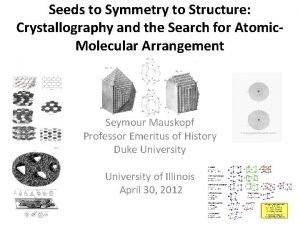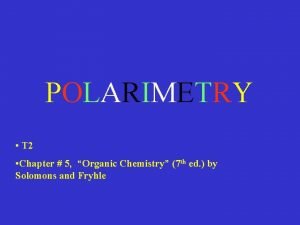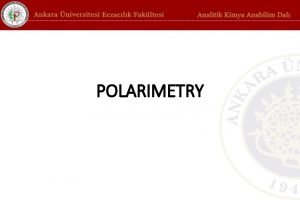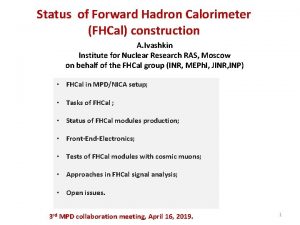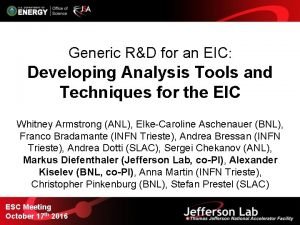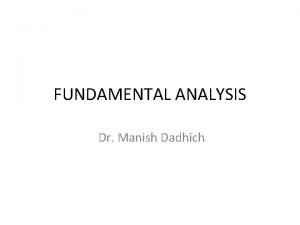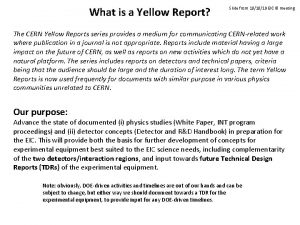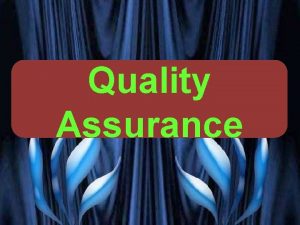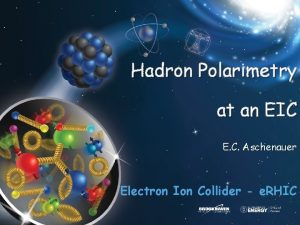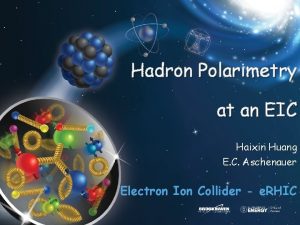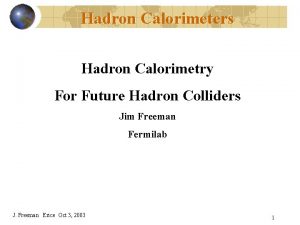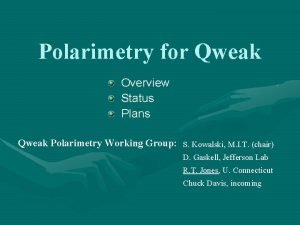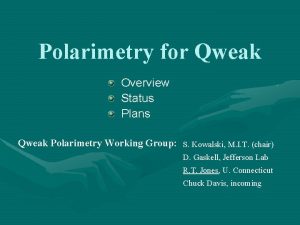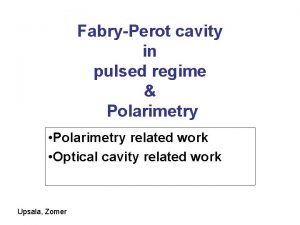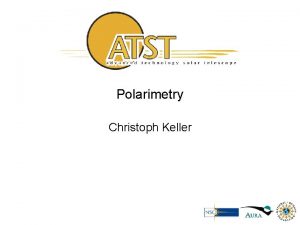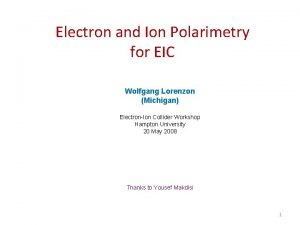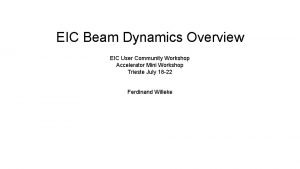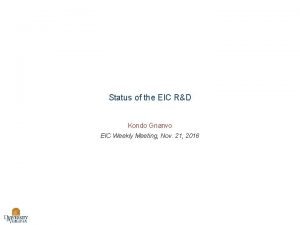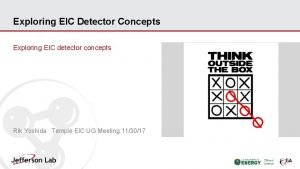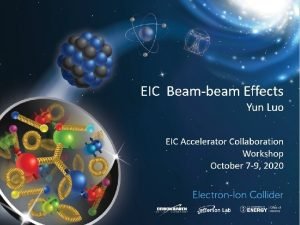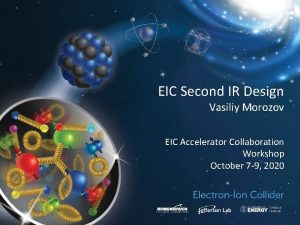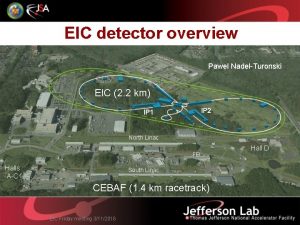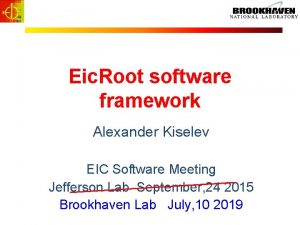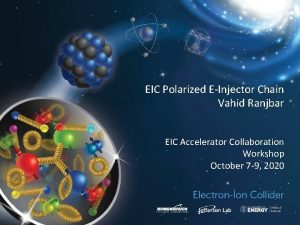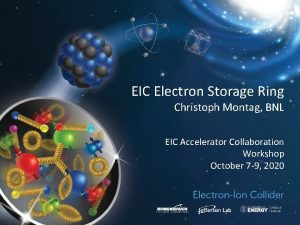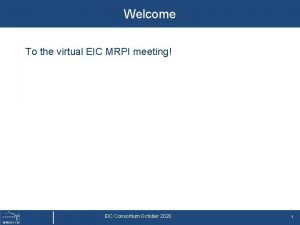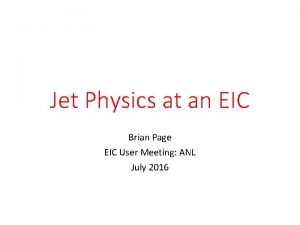Hadron Polarimetry at an EIC E C Aschenauer

























- Slides: 25

Hadron Polarimetry at an EIC E. C. Aschenauer Electron Ion Collider - e. RHIC

Requirements q Need high beam polarization Ø uncertainty of physics observable for both beams being polarized: q High EIC Luminosity Small statistical uncertainties requires small systematic uncertainties Ø high precision polarization measurement with small systematics ~1% Ø flexible bunch spin orientation q EIC first collider with polarized lepton and hadron beams Ø luminosity measurement depends on beam polarization Ø How big is “a”? Need a theorist to calculate q Polarization measurement needs to be same as the polarization seen in collision Ø need to know: polarization lifetime, bunch polarization profile in x, y, z, polarization per bunch q EIC first collider with polarized deuterium and He-3 beams Ø need to develop a concept to have high precision polarization measurements for polarized light ion beams 2 EIC-Collaboration Meeting, JLab 2018 E. C. Aschenauer

Lets learn from RHIC the world’s only polarized hadron collider Absolute Polarimeter (H-jet) p. C Polarimeters (2/ring) Siberian Snakes CEC / LERe. C e-Lens PH RHIC EN IX STAR Local IR Polarimeters Siberian Snakes Spin Rotators Pol. Proton Source 500 m. A, 400 ms LINAC Local IR Polarimeters Solenoid Snake BOOSTER AGS Warm Snake 200 Me. V Polarimeter AC Dipole Cold Snake 3 p. C Polarimeter EIC-Collaboration Meeting, JLab 2018 E. C. Aschenauer

Concept for Hadron Polarimetry Polarized hydrogen Jet Polarimeter (HJet) Source of absolute polarization (normalization of other polarimeters) Slow (low rates needs looong time to get precise measurements) Proton-Carbon Polarimeter (p. C) Very fast and high precision main polarization monitoring tool Measures polarization profile and lifetime Needs to be normalized to HJet IR Local Polarimeters Defines spin direction and degree of rotation in experimental area All of these systems are critical for polarization measurements and monitoring at RHIC Will be critical for EIC 4 EIC-Collaboration Meeting, JLab 2018 E. C. Aschenauer

How to measure proton beam polarization There are several established physics processes sensitive to the spin direction of the transversely polarized protons Scattering to the left Scattering to the right AN – the Analyzing Power (|AN|<1) (left-right asymmetry for 100% polarized protons) Once AN is known: 5 EIC-Collaboration Meeting, JLab 2018 E. C. Aschenauer

Polarized H-Jet Polarimeter Forward scattered proton RHIC proton beam H-jet target recoil proton Left-right asymmetry in elastic scattering due to spin-orbit interaction: interaction between (electric or strong) field of one proton and magnetic moment associated with the spin of the other proton Beam and target are both protons: Array of Si detectors measures TR & To. F of recoil proton. Channel # corresponds to recoil angle R. Correlations (TR & To. F ) and (TR & R ) the elastic process To. F vs. Energy Ptarget from Breit Rabi Polarimeter 6 EIC-Collaboration Meeting, JLab 2018 E. C. Aschenauer

P-Carbon Polarimeter: Left-right asymmetry in elastic scattering due to spin-orbit interaction: interaction between (electric or strong) field of Carbon and magnetic moment associated with the spin of the proton Carbon target Polarized proton 6 5 18 cm 4 7 Recoil carbon 1 2 3 Ultra thin Carbon ribbon Target (5 mg/cm 2) Si strip detectors (TOF, EC) Target Scan mode (20 -30 sec per measurement) Stat. precision 2 -3% Polarization profile, vertical, horizontal & longitudinal measurement of different spin projections Normalized to H-Jet measurements over many fills EIC-Collaboration Meeting, JLab 2018 E. C. Aschenauer

Polarization Profile If polarization changes across the beam, the average polarization seen by Polarimeters and Experiments (in beam collision) is different p. C Scan C target across the beam in both X and Y directions Collider Experiments Polarization Intensity H-Jet ~1 mm 6 -7 mm x=x 0 Target Position P 1, 2(x, y) – polarization profile, I 1, 2(x, y) – intensity profile, for beam #1 and #2 8 EIC-Collaboration Meeting, JLab 2018 E. C. Aschenauer

RHIC Hadron Polarisation Account for beam polarization decay through fill P(t)=P 0 exp(-t/tp) growth of beam polarization profile R through fill p. Carbon polarimeter Collider Experiments 2017 x=x 0 r o f eam : b t l w u o s l l e R or Ye f % 4. and 1 ow) l e s l u n e l o y i B t r u % trib % fo / 1. 3 n 1. o e 1 c u l d t b e s. 0% 1 chiev Bigge ( a t e e v j a H for H ofation 0. 5% n o correlation i t c aliz orre m c r o d n n t u o d. P/dt Je to d. R/dt backgr p. C/H-for all 2012 fills at 250 Ge. V Polarization lifetime has consequences for physics analysis different physics triggers mix over fill different <P> 9 EIC-Collaboration Meeting, JLab 2018 E. C. Aschenauer

Improvements to RHIC Hadron Polarimetry Concept q H-Jet: Ø continuously monitor molecular fraction in the H-Jet ü till 2017 dominant systematics uncertainty Recent research indicates a significant reduction q p. C-polarimeters Ø find longer lifetime and more homogenious target material for the p. C polarimeters ü Need to account for higher peak currents in EIC RF pickup Ø can we calibrate energy scale of p. C closer to E kin(C) in CNI Ø alternative detector technology for Si-detectors to detect C? Ø norm. emittance of e. RHIC hadron beam x-y polarization profile ü RHIC: 2. 5/2. 5 mm ü e. RHIC: 2. 7/0. 38 mm with cooling ü JLEIC: 0. 9/0. 18 mm with cooling 4. 1/2. 5 mm no cooling q polarised Deuterium and He-3 polarimetry will be challenging Ø How does D and He-3 break up impact the polarization measurement Ø would H-jet + D / H-jet + He-3 beam work as absolute polarimeter? q local polarimetry @ e. RHIC Ø integrate a p. C-polarimeter between the spin-rotators ü Magnitude of asymmetry directly proportional to longitudinal polarization 10 EIC-Collaboration Meeting, JLab 2018 E. C. Aschenauer

Reasons why polarization / Current CAN vary from Bunch to Bunch Polarisation: Hadrons in a storage ring: source instabilities Beam-Beam effects bunch-to-bunch emittance variation, Characteristic scale can be seen from AGS RHIC polarization profile variation for different bunches after acceleration leptons in a storage ring: Beam-Beam effects source instabilities Current: Hadrons & leptons in a storage ring: Variations in transfer efficiency from pre-accelerator to main ring beam-beam interaction is important, it affects the bunch lifetime during the store 11 EIC-Collaboration Meeting, JLab 2018 E. C. Aschenauer

EIC-h is not RHIC: Hadron beam parameters: Higher bunch frequency e. RHIC: # of bunches 660 —> bunch spacing 17. 4 ns —> bunch length 7 cm without cooling # of bunches 1320 —> bunch spacing 8. 7 ns —> bunch length 5 cm with cooling JLEIC: # of bunches —> bunch spacing 2. 1 ns —> bunch length 1 cm with cooling beam current / bunch: JLEIC 0. 98 1010 e. RHIC: 1. 5 1011 RHIC: 2. 4 1011 If 2 IRs, as strongly endorsed by EIC-UG e. RHIC luminosity will be shared not all bunches collide at both IRs need polarization per bunch 12 EIC-Collaboration Meeting, JLab 2018 E. C. Aschenauer

High Collision Frequency Challenge Scattered Carbon Distribution from RHIC: 0. 33 0. 67 1. 0 1. 3 Ekin, Me. V 1. 7 To. F (ns) 65 Pulser 40 16 width driven by detector resolution Background due to C’ from collisions width driven by bunch length q Collision related background leaks under the signal “Banana” background gone in empty target runs 13 EIC-Collaboration Meeting, JLab 2018 E. C. Aschenauer

High Collision Frequency Challenge Signal: vertical-width of To. F vs. Ekin will shrink as bunch length shrinks horizontal width remains the same if the detectors and targets are similar 660 bunches —> bunch spacing 17. 4 ns —> bunch length 13. 2 cm 1320 bunches —> bunch spacing 8. 7 ns —> bunch length 6. 6 cm q increased bunch number signal “bananas” overlap at low Ekin lose data with highest statistics and high analyzing power q EIC: No background included and no smearing in horizontal due detector energy resolution and energy loss in target smearing need to increase lower cut on Ekin lose data with high statistics & high analyzing power collision related C’ background smears from (N+1)s bunch to Ns bunch and lower impact on measuring bunch polarization A serious issue to provide precise measurement of polarization in collision for experiments 14 EIC-Collaboration Meeting, JLab 2018 E. C. Aschenauer

Background vs. Signal Asymmetry Background Asymmetry Signal Asymmetry Need to suppress this background 15 EIC-Collaboration Meeting, JLab 2018 E. C. Aschenauer

Next Steps / Mitigations q Need simulations to understand exact origin of collision related C’ background can we reduce / eliminate this background? can we change detector technology to have better energy and timing resolution Ø higher timing resolution Si: 16 ps can we experimentally suppress the background dominated by MIPs ? if yes MIPs punch through Si veto by 2 nd layer of Si-detectors q Can we utilize a different techniques to replace p. C polarimeters Use physics asymmetries: o AN for p+/- p 0 o AN for neutrons in p↑A-scattering Ø Possible Advantages Ø Sometimes larger analyzing power Ø Challenges Ø Need HI-targets, i. e. Au Ø Analyzing power drops as function of √s Ø More spatial needs for polarimeter Ø Statistical power obtain polarization lifetime and the bunch polarization profile Use an unpolarized H-jet colliding with polarized beam Ø luminosity 100 times polarized jet Ø no target lifetime issue like for the carbon-targets Ø But no measurement of x, y bunch beam profile 16 EIC-Collaboration Meeting, JLab 2018 E. C. Aschenauer

H-jet: details of Measurement from RHIC Same issue as for p. C polarimeter q Collision related background leaks under the signal “Banana” need to follow similar mitigation strategy BUT: no alternative absolute polarimeter All the same problems for polarized D and He-3 beams PLUS Need to ensure D/He-3 -beam particle does not break up during scattering with target? elastic scattering 17 EIC-Collaboration Meeting, JLab 2018 E. C. Aschenauer

Let’s get to work 18 EIC-Collaboration Meeting, JLab 2018 E. C. Aschenauer

19 EIC-Collaboration Meeting, JLab 2018 E. C. Aschenauer

20 EIC-Collaboration Meeting, JLab 2018 E. C. Aschenauer

RHIC Hadron polarisation and BUNCh Current Fill 17520 in 2013: Beginning Fill 17520 in 2013: End P↓ P↑ 21 EIC-Collaboration Meeting, JLab 2018 E. C. Aschenauer

RHIC Hadron polarisation and BUNCh Current Fill 17571 in 2013: Beginning Fill 17571 in 2013: End P↓ P↑ 22 EIC-Collaboration Meeting, JLab 2018 E. C. Aschenauer

RHIC: Polarisation-Bunch Current Correlation Data from 2012 -Run: 0, 03 0, 02 0, 01 0 -0, 02 -0, 03 -0, 04 -0, 05 -0, 06 -0, 07 50 100 150 200 250 300 B 2 Y 1 Y 2 Energy [Ge. V] Correlator vs. Energy Down Spin Small anti-correlation between polarization and bunch current at injection which washes out at collision energies should look to 2017 23 B 1 Correlator vs. Energy Up Spin 0, 03 0, 02 0, 01 0 -0, 02 -0, 03 -0, 04 -0, 05 -0, 06 -0, 07 -0, 08 50 EIC-Collaboration Meeting, JLab 2018 100 150 200 250 300 B 1 B 2 Y 1 Y 2 Energy [Ge. V] E. C. Aschenauer

Impact on ∫Dg from systematic uncertainties ar. Xiv: 1206. 6014 PRD 86 (2012) 054020 Dominant systematics: Luminosity Measurement Relative Luminosity relative luminosity needs to be controlled better then ALL ~10 -4 at low x Absolut polarization measurements: electron Pe and hadron Pp Need systematics 24 EIC-Collaboration Meeting, JLab 2018 ≤ 2% E. C. Aschenauer

Impact on correlated Systematic uncertainty in p+p p 0 ALL on DG ar. Xiv: 1402. 6296 relative luminosity 2009: Relative Luminosity uncertainty same size as physics asymmetry R=1. 18 x 10 -3 + 0. 21 x 10 -3 ALL= 0. 4 – 4 x 10 -3 25 EIC-Collaboration Meeting, JLab 2018 E. C. Aschenauer
 Biots law polarimetry
Biots law polarimetry Polarimetry organic chemistry
Polarimetry organic chemistry Polarimetry definition in chemistry
Polarimetry definition in chemistry Hadron collider
Hadron collider Hadron collider
Hadron collider Hadron
Hadron Hadron calorimeter
Hadron calorimeter Hadron
Hadron Eic software reviews
Eic software reviews Eic approach of fundamental analysis
Eic approach of fundamental analysis Yellow report eic
Yellow report eic Eic european investment centre
Eic european investment centre Fiu username
Fiu username Yellow report eic
Yellow report eic Qa eic patel
Qa eic patel Export inspection agency health certificate
Export inspection agency health certificate
